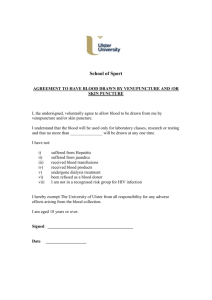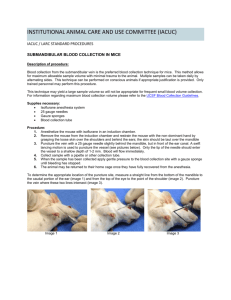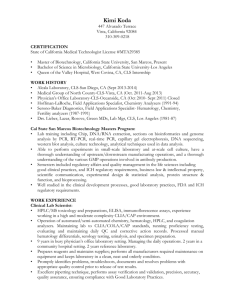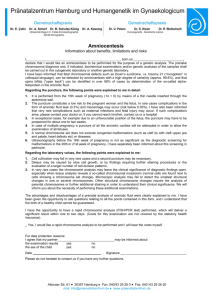Quality Assurance
advertisement
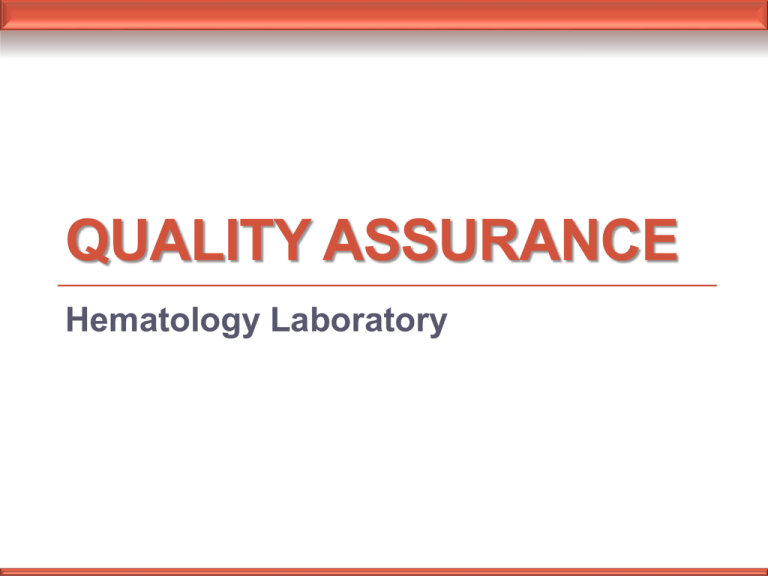
QUALITY ASSURANCE Hematology Laboratory • Hematology test procedures involve the enumeration and identification of the blood's various cells • Leukocytes, erythrocytes, and platelets are living cells that are much more sensitive to the test environment than most chemical components such as sodium or chloride 2 Specimen collection and sample quality • Improper sample collection procedures and sample processing can drastically affect: • the size, shape, number, and distribution of blood cells • Two methods of collecting samples are used: 1. capillary puncture 2. and venous puncture 3 1- Capillary puncture • Sometimes it is the only available method for obtaining blood from neonates and some geriatric patients • Site of puncture includes: • Ear, finger tip, and the plantar surface of the foot • Materials required: • Skin puncture devise (sterile blood lancet, or automatic lancet device) • Isopropyl alcohol, • Sterile gauze pads, • and microcollection system 4 1- Capillary puncture • The puncture site should be warm and pink, indicating good local circulation • It should be wiped with alcohol and allowed to dry • Alcohol can cause: RBCs lysis, RBCs clumping, or coagulation of blood protein • The use of automatic lancet devices that control the angle, depth, and force of the puncture helps standardize the process from one person to the next • During collection the sample, don't squeeze the puncture area and follow the following: • The first drop formed should not be collected but wiped away • Contain any remaining interstitial fluid released during puncture • The second drop used for platelet count and blood film • The third one used for WBCs count 5 1- Capillary puncture • Notes: • Blood from a skin puncture is a mixture of venous, arterial, and capillary blood • Some of constituents in the blood will differ between skin puncture blood and an arterial or venous blood • WBCs counts are high in the first drop (immune defense action) • Platelets count decrease gradually in each drop (clumping, platelet activators) • Squeezing of the puncture area introduce tissue fluid into the blood (dilution) 6 2- Venous puncture • Evacuated collection tube or syringe can be used • Site of collection: • veins in the antecubital fossa, the back of the hand, ankle, the femoral vein, and the jugular vein • A tourniquet is used for collection from the arm and the hand 1. 2. 3. The tourniquet is placed on the arm or the hand and the vein is palpated The site is cleaned with alcohol and the puncture made after the site has dried Once the vein has been punctured and the flow of blood into the syringe is established, the tourniquet should be removed 7 2- Venous puncture • Blood collected in syringe should be transferred immediately to an anticoagulated tube by carefully injecting the sample into the tube (without the needle attached) allowing it to run down the side • Slowly depress the plunger so as to avoid foaming or rupture of the cells • Stopper the tube and mix immediately by inversion to prevent clotting 8 Anticoagulants • Ethylenediamine tetraacetate (EDTA) • The anticoagulant of choice in providing whole blood for most hematology procedures • Samples collected in EDTA should be tested within four hours and, • If refrigerated at 4oC, are reliable for white blood cell (WBC) counts and microhematocrit determinations for up to 48 hours, and for platelet counts for 24 hours • Sodium citrate • Used as the anticoagulant for most coagulation procedures • Can be used to determine the WBC and platelet count on patients who form platelet clumps when EDTA is used • It causes RBC shrinking • Inaccurate RBC count and hematocrit 9 Anticoagulants • Heparin • Reliable for Hb, PCV, and ESR • Cause WBC to clump together, and result in a blue background on Wright-stained smears • • Ammonium/potassium oxalate • For ESR only 10 Errors encountered in specimen collection 1. Inappropriate anticoagulant for the test performed 2. Failure to mix the sample thoroughly 3. Under filling or overfilling the collection tube, resulting in the improper sample: anticoagulant ratio 4. Misidentification of the patient 5. "Milking" of the site of skin puncture to obtain more blood 6. Rough or inappropriate handling of specimen after it is collected, • e.g., exposure to extreme heat or cold 11 Procedure Manual 1. 2. The description of each of the cell types found in the blood and in other body fluids should be clearly defined in writing Outline how the results of WBC differentials and blood film examinations are to be reported • Eliminate the use of ambiguous terms such as large, moderate, or small, if semi quantitative terms must be used, • define a table describing exactly what 1+, 2+ or 3+ constitutes as a percentage of cells found in the oil immersion field 3. 4. 5. The criteria requiring the review of specimen by a hematologist or pathologist should be defined in the technical procedure A definitive procedure for the calibration of automated single-and multiparameter cell counting instruments is included in the technical procedure manual Quality control procedures, the tolerance limits, and actions to betaken when the limits are exceeded are also defined in the procedure manual 12 Referance Intervals • There are measurable biases between the various methods employed by hematology analyzers in identifying, counting, and measuring blood cells and hemoglobin, • There is also significant age and sex differences for hemoglobin, hematocrit, and the percentages of Leukocyte distributions • Example of the variation of reference intervals of hemoglobin • Newborn: 14-24 g/dl • Infants: 10.5-14.5 g/dl • 1-5 Years: 10.5-14.9 g/dl • 6 - Adolescent: 11-14.9 g/dl • Adult Males: 14.0-17.0 g/dl • Adult Females: 12.5-15.0 g/dl 13 Choice of Methods: Hematology Analyzers • The proper selection of a hematology analyzer is an important decision that can prevent or reduce the number of problems that might occur as instrument is put into full service • You must consider the following when you choose the analyzer: • Sample volume • Instrument maintenance • Types of problems encounterd in identifying and counting cells • Differentiation between WBC and nucleated RBCs • Low WBCs count 14 Choice of Methods: Hematology Analyzers • The evaluation of a hematology analyzer's accuracy and precision is a little different than that for a chemistry analyzer • The evaluation of a new hematology analyzer is carried out by comparing fresh patient samples to: • Manual reference methods • Instruments whose performance characteristics, precision, and accuracy are well documented 15 Precision Evaluation • Replicate analyses of patient samples (used for measuring within run precision) • 20 consecutive times • mean, S.D, %CV are calculated and must be ≤ the published limits for the instrument • Duplicate analysis within the same run or in later test detect the degree of variation • NOTE: • There are two instrumentation methods used widely: 1. Aperture impedance technology 2. Light scattering technology (Laser) 16 The Properties of a Good Commercial Blood Control 1. The cells should maintain the size and shape of human blood cells 2. The cells should behave in a manner similar to blood cells in: • Deformability, fragility, index of refraction • Physical properties: conductivity, viscosity, pH, turbidity 3. The material should suspend readily without doublet formation 4. The material should be able to be used directly without any preparation or manipulation other than warming to room temperature and mixing 17 Use of Patient Samples for Quality Control of Hematology Analyzers • The use of patient sample as controls is attractive for several reasons: The problem of the physical differences and sensitivity to the testing system between the control and the patient sample is absent when the patient sample is the control sample 2. The data generated by the analysis of the patient sample requires no extra effort to obtain for quality control data especially if the data is captured by the microcomputer on the analyzer of the laboratory computer 3. The use of patients as controls is perceived as a less expensive method of quality control, since additional control material need not be purchased 1. 18 Calculation of RBCs Indices • The red cell indices are calculated by the following formulas: • Mean corpuscular volume (MCV) = HCT/RBC *10 (fl) • Mean corpuscular Hemoglobin (MCH) = HGB/RBC * 10 (pg) • Mean corpuscular Hemoglobin Conc. (MCHC) = HGB/HCT * 100 (%) • The distribution of these values in the hematological healthy population is: 1. 2. 3. Constant Homogenous Has a Gaussian distribution • Patient’s samples that affect the calculation are: • Patients with microcytosis RBCs • Patients with macrocytosis RBCs • Patients with atypical shaped RBCs (newborns, sickle cell anemia) 19 Rule of Thumb Method for Checking Red Cell Values • A method which can be applied at the instrument results to check validity of red cell count, HGB and HCT • HGB X 3 = HCT (± 2) • HCT + 6 (± 3) = first 2 digits of red cell count • Example: RBC = 3.62 X 1012 /L, HGB =11.1 g/dl, HCT = 32.6 % • HGB X 3 = HCT (± 2) = 11.1 X 3 = 33.3 (30.6 - 34.6) • HCT + 6 (± 3) - first 2 digits of red cell count = 32.6 + 6 ± 3 =35.6-41.6 • These formulas apply to individuals with healthy red cells • If the instrument is not performing well, all of the results will be consistently outside of those ranges 20
